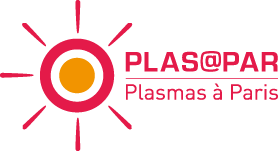
Interaction of plasmas with solids, liquids and living matter
- Laboratories: LPP, ONERA, IJLRA, LESIA, INSP, LISE, LCPMR
- Number of researchers involved: about 50
- Publications (2012-2018): more than 400
This theme brings together fields of scientific investigation closely linked to industrial and societal applications, covering microelectronics, space propulsion and innovative materials such as medicine, air pollution control or agriculture.
It aims to identify the key parameters of plasma to induce target changes whether they are liquid (water), solid (polymers, nanomaterials) or biological (cell, tissue, bone, organ, etc.). In particular, the following properties of plasma will be studied in depth: electric field, temperature, reactive species, radiation or gas flow. To this end, different techniques will be used, i.e. OES, OAS, MS, GC, IR imaging, ICCD imaging, XPS, SEM, FTIR, SIMS. In this context, it will be necessary to study how these properties interact with respect to the intended application, i.e. whether the properties of the plasma act synergistically or, on the contrary, competitively.
In the biomedical field, we will strive to design innovative plasma sources capable of responding to the major challenges of contemporary medicine, in particular in the fields of oncology, dermatology and decontamination. Compared to targeted diseases for which conventional solutions provide only a partial response, we will evaluate the potential of cold plasmas as an innovative or complementary therapeutic option. The problems of chemical selectivity, the absence of harmful effects in the short, medium and long terms will also be addressed.
In the field of surface treatments, we will study what advantages plasma processes can provide compared to more conventional processes, the aim being to offer incremental and disruptive technological solutions, capable of being part of a logic of sustainable development. Research work has already been carried out on these issues; they are a basis for promoting the results of research in various economic sectors, particularly in the field of microelectronics.
In addition, the interaction of plasmas with solids is also interested in the destructive aspects of the interaction of solid energetic particles (for example for the radiation belt), in the plasma-wall interaction (fusion by magnetic confinement), in the study of the lightning arc-foot phenomenon (interaction with the cabin and creation of reverse plasma jets), analyzed in the community of the Research Federation from an experimental and numerical point of view.
Understanding the interaction of plasmas with liquids, solids and living matter is fundamental in many applications.
ILLUSTRATION: Illustration of the work carried out on lightning to improve safety in the aeronautical field (ONERA, LPP). © ONERA
